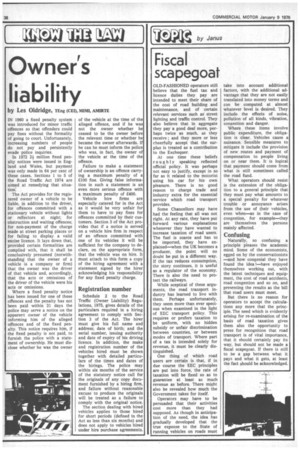Owner s liability
Page 40

If you've noticed an error in this article please click here to report it so we can fix it.
by Les Oldridge, TEng (CEI), MIMI, AMIRTE
IN 1960 a fixed penalty system was introduced for minor traffic offences so that offenders could pay fines without the formality of going to court. Unfortunately, increasing numbers of people do not pay and persistently evade police inquiries.
In 1972 21 million fixed penalty notices were issued in England and Wales, but payment was only made in 64 per cent of these cases. Sections 1 to 5 of the Road Traffic Act 1974 are aimed at remedying that situation.
The Act provides for the registered owner of a vehicle to be liable, in addition to the driver, for offences committed with a stationary vehicle without lights or reflectors at night; for obstruction and waiting offences; for non-payment of the charge made at street parking places or for failing to display a valid excise licence. It lays down that, provided certain formalities are complied with, that it shall be conclusively presumed (notwithstanding that the owner of a vehicle is a company or firm) that the owner was the driver of that vehicle and, accordingly, that the acts or omissions of the driver of the vehicle were his acts or omissions.
Where a fixed penalty notice has been issued for one of these offences and the penalty has not been paid within 21 days the police may serve a notice on the apparent owner of the vehicle informing him of the alleged offences and of the fixed penalty. This notice requires him, if the fixed penalty is not paid, to furnish the police with a statement of ownership. He must disclose whether he was the owner of the vehicle at the time of the alleged offence, and if he was not the owner whether he ceased to be the owner before the relevant time or whether he became the owner afterwards. If he can he must inform the police who was, in fact, the owner of the vehicle at the time of the offence.
Failure to make a statement of ownership is an offence carrying a maximum penalty of a E100 fine. Giving false information in such a statement is an even more serious offence with a maximum penalty of £400.
Vehicle hire firms are especially catered for in the Act as it would be very unfair for them to have to pay fines for offences committed by their customers. Section 3 of the Act provides that if a notice is served on a vehicle hire firm in respect of an offence committed with one of its vehicles it will be sufficient for the company to declare, on the appropriate form, that the vehicle was on hire. It must attach to this form a copy of the hiring agreement with a statement signed by the hirer acknowledging his responsibility for any fixed penalty charge.
Registration number
Schedule 2 to the Road Traffic (Owner Liability) Regulations, 1975, gives details of the particulars required in a hiring agreement to comply with Section 3 of the Act. The hirer must give his full name and address; date of birth; and the serial number, issuing authority and date of expiry of his driving licence. In addition, the make and registration number of the vehicles hired must be shown together with detailed particulars of the times and dates of the hirings. The police may within six months of the service of the statutory notice call for the originals of any copy document furnished by a hiring firm, and failure without reasonable excuse to produce the originals will be treated as a failure to comply with the original notice.
The section dealing with hired vehicles applies to those hired for short periods (defined in the Act as less than six months) and does not apply to vehicles hired under hire purchase agreements.




















































































